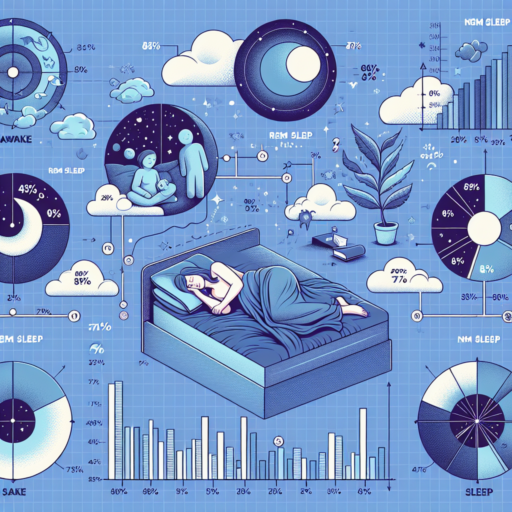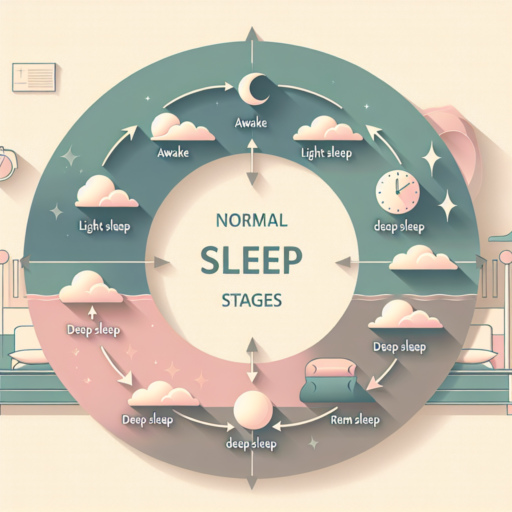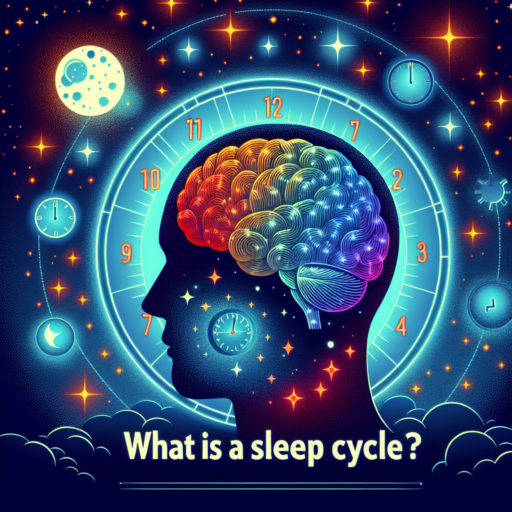No se han encontrado productos.
Understanding Sleep Stages: An Overview
Sleep is a complex and dynamic process that is crucial for our well-being and health. It is not just a state of rest, but a series of stages that cycle throughout the night. Each stage of sleep serves a unique purpose in the restoration and rejuvenation of the body and mind. Understanding these stages can provide insights into the quality of sleep one is getting and how it affects overall health.
The first stage of sleep, often referred to as light sleep, acts as a transition period from wakefulness into deeper sleep stages. During this time, the body begins to relax, with heart rate and breathing slowing down. It’s a relatively short phase but is crucial for starting the sleep cycle. The second stage is where the body starts to prepare for deep sleep. Here, the brain starts producing sleep spindles, which are bursts of brain activity that play a role in consolidating memories and learning.
Deep sleep, or slow-wave sleep, is the third stage and is vital for physical recovery, immune function, and growth. It is during this stage that the body repairs muscles and tissues, stimulates growth and development, and boosts immune function. The brain activity slows down significantly, making it harder to be awakened. The last stage, known as REM sleep (Rapid Eye Movement), is where most dreaming occurs. The brain becomes more active, and this stage plays a key role in emotional regulation and memory. Notably, the sleep cycle repeats several times during the night, with an increasing proportion of REM sleep in the later cycles.
Each of these stages of sleep contributes to the complex process of brain and body restoration. Disruptions in the sleep cycle can lead to a plethora of health issues, signaling the importance of understanding and prioritizing good sleep habits. By recognizing the characteristics and significance of each sleep stage, individuals can better appreciate the role of sleep in maintaining health and well-being.
What Is a Normal Sleep Cycle?
Understanding a normal sleep cycle is crucial for recognizing the quality of sleep one is getting. At its core, a normal sleep cycle consists of several stages, including both REM (Rapid Eye Movement) and NREM (Non-Rapid Eye Movement) sleep phases. These cycles are elemental in ensuring that the body and mind rest adequately, processing the day’s events, and rejuvenating for the tasks ahead.
The duration and frequency of these cycles can vary among individuals, yet typically, a healthy adult goes through four to six cycles per night. Each cycle spans approximately 90 to 120 minutes, showcasing a progression through the NREM stages before reaching REM sleep. The NREM stages account for 75-80% of total sleep time, signifying their indispensable role in physical restoration, while the REM stage is often associated with dreaming and mental consolidation.
Delving deeper, the initial stage of NREM sleep serves as a transition period from wakefulness to sleep, lasting for a few minutes. Progressing, the body enters a deeper state of relaxation during the second stage, wherein heart rate and body temperature decrease. The third stage of NREM sleep is where profound restorative processes occur, including tissue repair and growth hormone release. Finally, REM sleep facilitates memory consolidation, brain detoxification, and supports overall cognitive health. Notably, the proportion of REM sleep increases in later cycles, which emphasizes its integral role in a refreshing sleep experience.
Breaking Down the Stages of Sleep: Light, Deep, and REM
Understanding the complexity of sleep involves diving into the three fundamental stages: light, deep, and REM (Rapid Eye Movement) sleep. Each stage plays a crucial role in our body’s recovery process, impacting everything from mental health to physical well-being. Let’s explore these stages to uncover the secrets behind a good night’s sleep.
Light Sleep: The Gateway to Dreamland
The journey into nocturnal rest begins with the light stage of sleep. This preliminary phase acts as a bridge between wakefulness and sleep, preparing the body for a deeper slumber. During light sleep, heart rate and breathing start to slow down, allowing the muscles to relax. It’s a period of easy awakening, but crucial for moving into more restorative sleep stages. Highlighting its importance, light sleep also aids in memory consolidation and information processing.
Deep Sleep: The Restoration Phase
Following light sleep, we descend into the deep sleep stage. This phase is the epitome of restorative sleep, with the body dedicating itself to repairing muscles, consolidating memories, and releasing growth hormones. It’s a state from which waking up is difficult, signifying a detachment from the external environment. The deep sleep stage is critical for physical recovery, supporting immune function, and fostering growth and development.
REM Sleep: When Dreams Occur
REM sleep, named for the rapid eye movements that occur, heralds the dream phase of our sleep cycle. It typically starts about 90 minutes after falling asleep and recurs several times throughout the night, lengthening with each cycle. This stage is associated with increased brain activity, resembling wakefulness, which facilitates dreaming, learning, and memory. The brain processes emotions and memories during REM sleep, making it essential for emotional regulation and cognitive functions.
How Much Time Should You Spend in Each Sleep Stage?
Understanding the optimal duration one should spend in each sleep stage is crucial for improving sleep quality. While individual needs may vary, there are general recommendations to consider. The sleep cycle consists of four stages: three stages of Non-REM sleep and one REM (Rapid Eye Movement) sleep stage. Balancing time spent in each stage is key to waking up feeling refreshed.
The Importance of Deep Sleep
Deep sleep, or Stage 3 of Non-REM sleep, is critical for physical restoration, memory consolidation, and immune system strengthening. Adults are advised to spend approximately 13-23% of their sleep in this stage. This translates to about 60-90 minutes for a typical 8-hour sleep period. Achieving sufficient deep sleep is integral for overall health and well-being.
Optimizing REM Sleep
REM sleep, the stage associated with dreaming, plays a pivotal role in emotional regulation and memory. For a healthy adult, approximately 20-25% of sleep should be in the REM phase, which amounts to around 90-120 minutes during an 8-hour sleep. Interestingly, REM sleep periods increase in duration in the second half of the night, emphasizing the importance of a full night’s sleep for adequate REM exposure.
The Importance of Each Sleep Stage for Health and Well-being
Sleep, often overlooked, plays a pivotal role in our health and well-being. It’s not just about the quantity but the quality and the journey through various sleep stages that matter. Each stage of sleep serves a unique purpose in rejuvenating our body and mind, making the understanding of these stages crucial for optimizing our health.
Understanding the Sleep Cycle
The sleep cycle comprises several stages, including light sleep, deep sleep, and REM (Rapid Eye Movement) sleep. Light sleep acts as a gateway to deeper rest, promoting muscle relaxation and a decrease in heart rate. Deep sleep is vital for physical recovery, tissue repair, and immune system strengthening. Finally, REM sleep plays a key role in memory consolidation, emotional regulation, and creativity. Each of these stages cycles throughout the night, ensuring a comprehensive restorative process.
The Physical and Mental Health Benefits
Understanding the importance of each sleep stage can significantly impact our physical and mental health. Deep sleep, for instance, allows our bodies to repair themselves, contributing to improved stamina and energy for the next day. On the other hand, adequate REM sleep supports our brain’s ability to learn, remember, and regulate emotions, highlighting its role in mental health. Consequently, ensuring that we cycle through each stage adequately can enhance overall well-being and life quality.
Inadequate sleep or disruptions in the sleep cycle can lead to a range of health issues, from impaired cognitive function and mood disorders to increased susceptibility to chronic diseases. Thus, appreciating and optimizing each sleep stage can serve as a foundational element in a holistic approach to health and well-being.
Identifying and Improving Abnormal Sleep Patterns
Certainly, focusing on the topic of identifying and improving abnormal sleep patterns allows for a detailed exploration into common sleep disturbances and actionable steps towards healthier sleep habits.
Abnormal sleep patterns, ranging from insomnia to oversleeping, can significantly impact our daily lives. Not only does it affect our energy levels, but it also influences mood, health, and overall productivity. Identifying these patterns is the first critical step towards improvement. Typically, signs of abnormal sleep include difficulty falling asleep, frequent waking during the night, feeling unrefreshed after sleep, or excessive daytime sleepiness.
Once identified, several strategies can be employed to improve these patterns. Creating a conducive sleep environment is essential. This involves ensuring the bedroom is dark, quiet, and cool. Reducing blue light exposure from screens before bed can also help regulate sleep cycles. Moreover, establishing a consistent sleep schedule can significantly improve sleep quality. Going to bed and waking up at the same time each day helps synchronize the body’s internal clock, promoting better sleep.
Adopting Healthy Lifestyle Choices
Adopting healthy lifestyle choices plays a pivotal role in enhancing sleep quality. Incorporating regular physical activity into your routine not only improves overall health but also promotes deeper, more restorative sleep. Furthermore, avoiding caffeine and heavy meals close to bedtime can prevent disruptions to your sleep cycle. Instead, focusing on a balanced diet that supports good sleep is crucial.
Tools and Techniques for Tracking Your Sleep Stages
Understanding your sleep patterns is crucial for enhancing your overall health and well-being. Fortunately, with the advent of innovative tools and techniques, tracking your sleep stages has never been easier. These methods not only help in recording the time spent in each sleep phase but also assist in identifying any disruptions that might affect your sleep quality.
Wearable Sleep Trackers
Among the most popular devices for this purpose are wearable sleep trackers. These gadgets, worn on the wrist or as a headband, use sensors to monitor your movements and physiological signals during sleep. By leveraging advanced algorithms, they effectively differentiate between light sleep, deep sleep, and REM stages, providing a detailed overview of your sleep cycle.
Smartphone Apps for Sleep Monitoring
In addition to wearables, numerous smartphone apps have emerged as a convenient option for tracking sleep stages without the need for extra devices. Utilizing the smartphone’s accelerometer and microphone, these apps analyze your movements and sounds to estimate your sleep patterns. While they may not offer the precision of dedicated sleep trackers, they remain an accessible and useful tool for gaining insights into your sleep habits.
The integration of these tools into your nightly routine can furnish invaluable data, allowing you to make informed adjustments for improving your sleep quality. By understanding the intricacies of your sleep stages, you’re better equipped to tackle insomnia, enhance cognitive function, and elevate your overall health status.
How Does Age Affect Your Sleep Stage Distribution?
The relationship between age and sleep stage distribution is a topic of significant interest within both medical and psychological fields. As individuals progress through different stages of life, the pattern and quality of sleep undergo various transformations that could influence overall health and well-being. Understanding these changes is key to acknowledging how critical sleep is across all ages.
Infancy and Childhood: During the early years of life, a substantial portion of sleep is dedicated to REM (Rapid Eye Movement) sleep, a stage associated with brain development and learning. Infants, for example, spend about 50% of their sleep time in REM, a rate that significantly diminishes as they grow older. This transition underscores the role of sleep in cognitive and physical development during these formative years.
Adulthood: Moving into adulthood, there’s a notable shift in sleep stage distribution. Adults spend a larger proportion of their sleep in the deep stages of non-REM sleep, which is crucial for physical recovery, hormone regulation, and immune system functioning. However, the exact distribution can be influenced by lifestyle factors, stress levels, and health conditions, showcasing the complexity of sleep’s relationship with age.
Later Life: In older adults, there is a further evolution in sleep patterns. This demographic tends to experience a decrease in deep non-REM sleep and an increase in lighter sleep stages, coupled with more frequent awakenings throughout the night. These changes can contribute to less restorative sleep, impacting day-to-day energy levels and potentially exacerbating age-related health issues.
Common Sleep Disorders and Their Impact on Sleep Stages
Sleep is a critical aspect of our health, and its quality can significantly impact our daily life. Various sleep disorders disrupt the sleep cycle, affecting different sleep stages. Understanding these disorders is essential for recognizing and addressing the issues they may cause.
Insomnia is perhaps the most widely recognized sleep disorder, which primarily affects the ability to fall asleep and stay asleep. It can severely disrupt the progression through the sleep stages, particularly deep sleep and REM sleep. This disorder can lead to daytime fatigue, mood disturbances, and decreased overall health.
Narcolepsy and Its Effect
Narcolepsy is a condition characterized by an uncontrollable urge to sleep, causing individuals to fall asleep at inappropriate times. This disorder can profoundly affect the REM sleep stage, leading to symptoms such as sudden loss of muscle tone and vivid hallucinations. People with narcolepsy may find their REM sleep occurring at unusual times, thereby disturbing the natural sleep cycle.
Sleep Apnea and Sleep Stages
Sleep apnea, particularly obstructive sleep apnea, involves repeated breathing interruptions during sleep. This condition drastically impacts sleep quality by causing numerous awakenings throughout the night, thus hindering the smooth progression through sleep stages. These interruptions primarily affect light sleep stages but can also reduce the amount of time spent in deep sleep, which is crucial for physical restoration.
Tips for Achieving a Healthy Sleep Cycle
Achieving a healthy sleep cycle is essential for both physical and mental health. In our fast-paced world, where screens dominate and schedules are packed, many individuals find it challenging to get adequate, quality sleep. However, there are several effective strategies to enhance your sleep cycle, leading to improved overall health and well-being.
Establish a Consistent Sleep Schedule
One of the most effective ways to achieve a healthy sleep cycle is to go to bed and wake up at the same time every day, even on weekends and holidays. This helps regulate your body’s internal clock, making it easier to fall asleep and wake up naturally. Although it might be tempting to sleep in on weekends, maintaining consistency is key for long-term success.
Optimize Your Sleeping Environment
Creating a restful environment is crucial for good sleep quality. Minimize noise, light, and excessive temperatures in your bedroom. Investing in a comfortable mattress and pillows can also make a significant difference. Additionally, consider using blackout curtains, earplugs, and white noise machines if you are particularly sensitive to disturbances.
Limit Exposure to Screens Before Bed
In today’s digital age, our exposure to screens is almost continuous. However, the blue light emitted by phones, computers, and TVs can interfere with your sleep cycle. Avoiding screen use at least one hour before bed can significantly improve your sleep quality. Instead, consider reading a book or practicing relaxation techniques such as meditation or deep-breathing exercises to help you unwind before bed.




